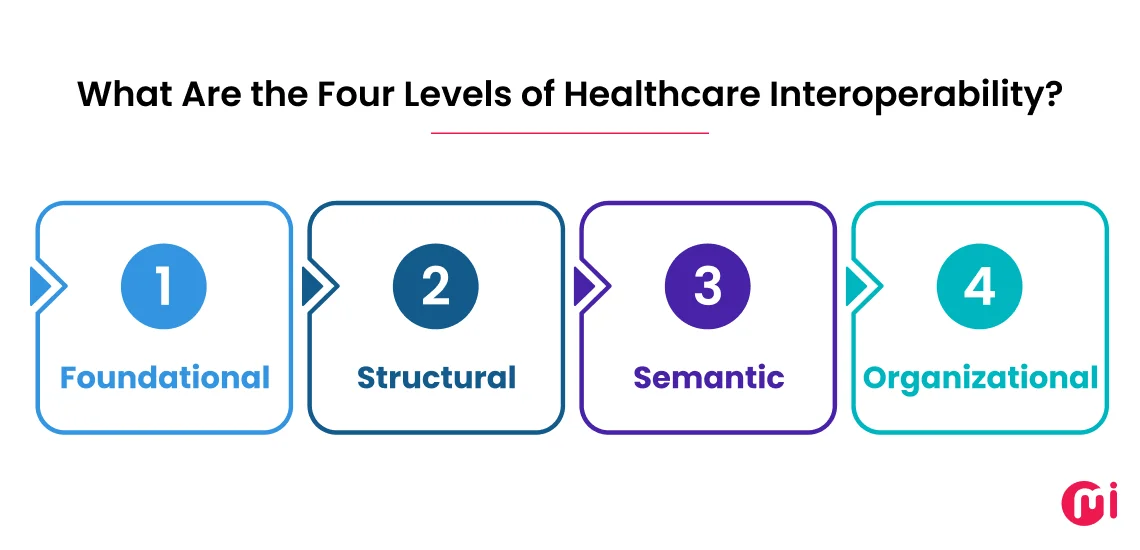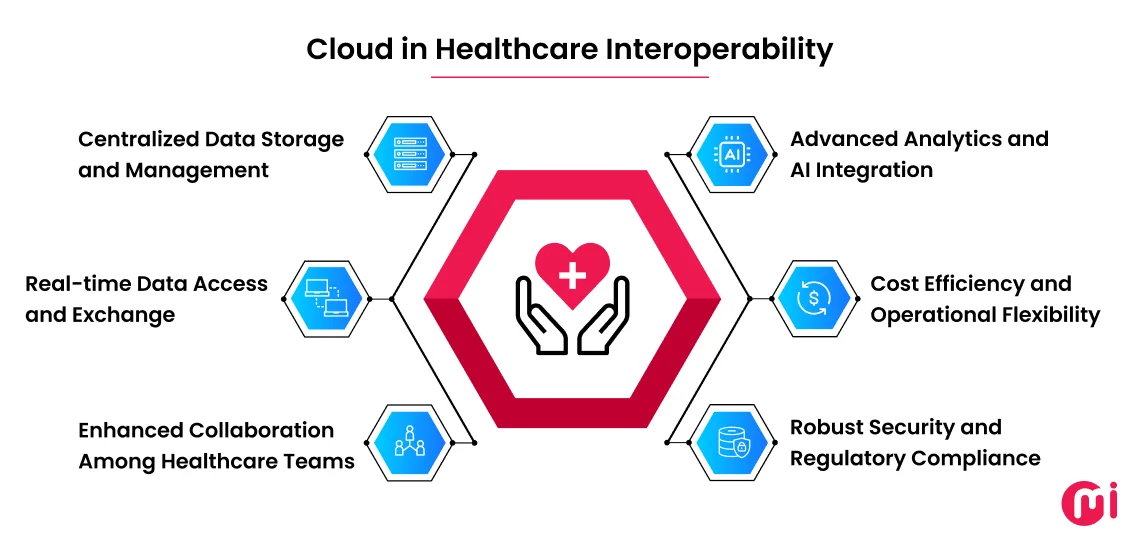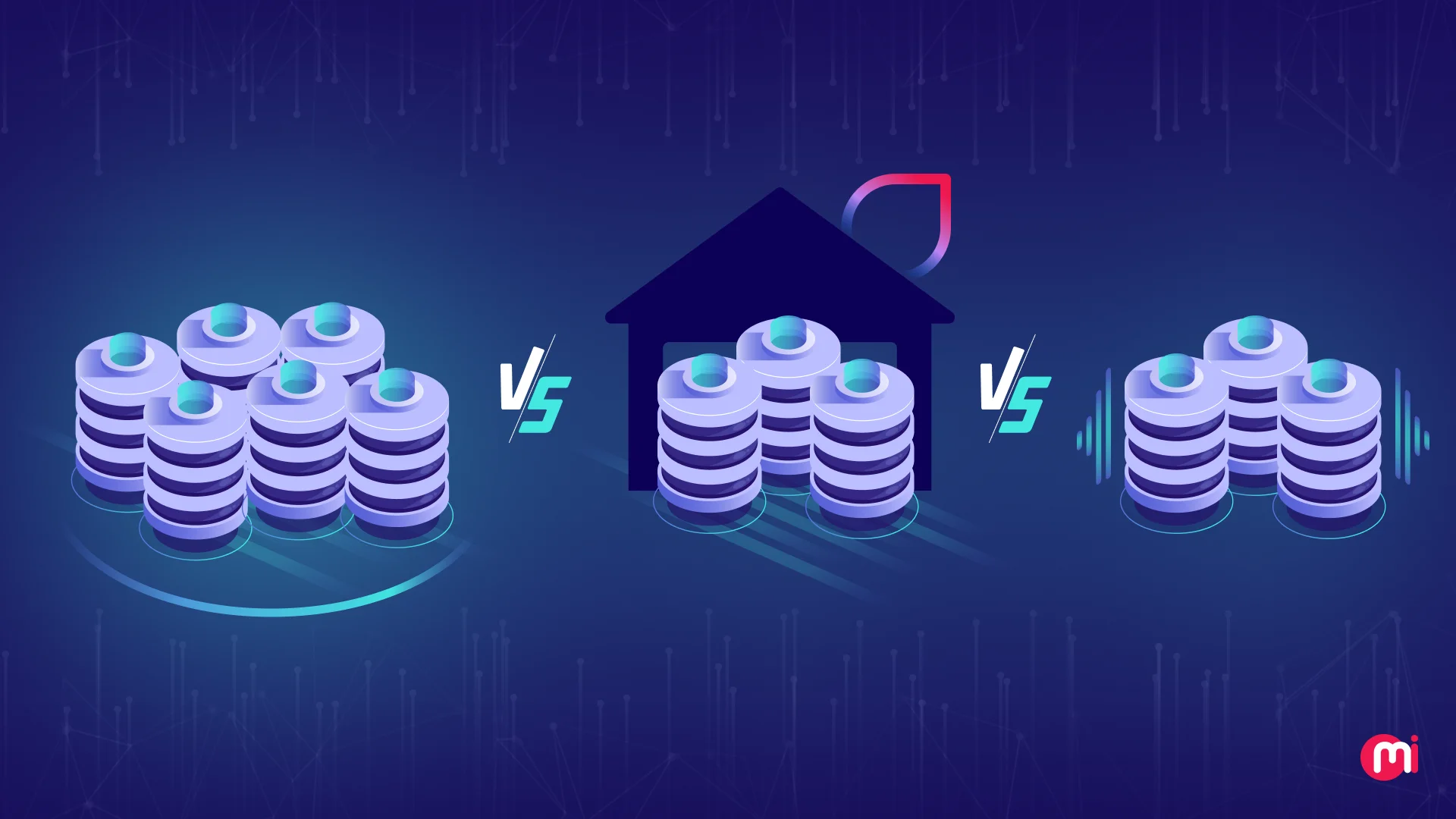Interoperability in Healthcare: Everything You Need to Know
- Data
- April 30, 2025
Interoperability in healthcare goes beyond just connecting systems, enabling seamless data exchanges and improving care coordination across providers. This blog explains interoperability in healthcare, what the must-know benefits of healthcare interoperability are, how to achieve it, and challenges in achieving it that must be addressed.
While reading about how U.S.-based healthcare institutions are adopting TEFCA (Trusted Exchange Framework and Common Agreement) to streamline data exchange, I couldn’t help but reflect on my own experiences over my decade plus years.
With exposure to working on various healthcare industry-specific projects, I’ve repeatedly encountered the same set of challenges: fragmented systems, data silos, clinical and administrative staff burnout, and revenue loss.
Digging deeper into project data and market research, I found that nearly 84% of healthcare providers struggle with interoperability. This is because they rely on software systems for different purposes that too are built by 20+ vendors. It’s not surprising that such complexity leads to operational stress and inefficiency.
In today’s healthcare environment, the demand for unified platforms that seamlessly connect departments and enable secure information sharing has never been greater. For instance, hospital management software connects different departments and allows them to fetch information that they should know without disrupting any other departments’ flow.
Therefore, I thought of writing a blog that covers all the details about interoperability in healthcare from importance to steps to achieve to challenges and more.

What Is Interoperability in Healthcare?
Interoperability in healthcare is the ability to access, exchange, interpret, and use data seamlessly across different health information systems, devices, and applications regardless of organizational, geographic, and technological boundaries.
Whether for local clinics, large hospitals, or regional health networks, interoperability in healthcare helps to exchange, interpret, and use data seamlessly.
It enables healthcare providers to build an integrated ecosystem that makes patient information readily available to clinicians, administrators, and even patients. Interoperability in healthcare even enables them to securely share data across different departments and hospital branches (regardless of regions).
But what are these data getting exchanged via interoperable healthcare systems?
It could be patients’ personal information, treatment plans, consultation data, data about their visits, lab test data, medication history, side effects, and allergies.
It all becomes possible thanks to APIs that act as bridges between disparate healthcare applications, HIEs providing a network to electronically share health-related information among organizations, HL7 and FHIR (Fast Healthcare Interoperability Resources) standards.
Above all, cloud engineering services act as hero tech enablement that offers healthcare facilities centralized data storage and access, scalability and flexibility, seamless integration with HIEs, and enhanced collaborations among providers with remote access over internet connectivity.
The Role of Interoperability in Modern Healthcare Delivery
In response to your next query, “Why does it matter? Or what’s the importance of interoperability in healthcare?” I’d say those hospitals and hospices that achieve interoperability can have
- Coordinated patient care across regions for improved patient care
- Real-time decision making at scale
- Better clinical care decision-making with data analytics
- Streamlined workflows and administrative processes
- Reduction in health care errors and costs
- Enhanced patient engagement
- Push to collaborative research, clinical trials, and the development of innovative healthcare solutions
What Are the 4 Levels of Interoperability in Healthcare?
In my experience working on healthcare software development projects, I figured the sector is highly structured, where health IT interoperability is critical to ensure flawless data exchange. In the HIMSS study, I found it has distinguished healthcare interoperability standards into four categories: foundational, structural, semantic, and organizational.
Let’s get to know more about these four levels of interoperability in the healthcare industry:

Level 1: Foundational
It plays a key role in establishing interconnectivity between multiple software from different vendors that are used within healthcare organizations. It’s responsible for making those healthcare systems securely share data with each other.
Level 2: Structural
As the name suggests, it defines the format and syntax in which data exchange should be done. It enables healthcare systems to interpret (parse and display information accurately) data at the data field level. So data can be used more efficiently.
Level 3: Semantic
At this level, shared models and codification of data (leveraging standards like SNOMED CT or LOINC) are used in integrated healthcare systems. This way, it ensures that different systems can understand and process the information in the same way as shared. This way of information sharing is highly essential for advanced functions like clinical decision support and analytics.
Level 4: Organizational
When implementing healthcare interoperability at the organizational level, it’s a must to comply with healthcare policy and social, legal, and organizational considerations.
When health IT operability is achieved considering all the highest-level organizational terms, it can help to ensure secure, seamless, and timely communication and use of data across organizations. As an added advantage, organizations build trust, allow shared consent, and help all healthcare providers to work together better.
Cloud integration services are what make all the layers click, so you better not skip it.
Examples of Interoperability in Healthcare
Interoperability in healthcare is all about sharing and using data across different systems for better-coordinated patient care. But how healthcare interoperability is used in the real world is also important to know. Here are some specific examples of interoperability in healthcare that you can also aim to achieve:
1. Electronic Health Record (EHR)
EHR – Electronic Health Record is a centralized and shareable patient record that stores information on patients’ diagnoses, treatments, medications, and test results. Healthcare professionals use EHR interoperability to easily access patient data and share it with others for better coordination of patient care and outcomes.
Example: A patient visits a specialist, and their primary care physician’s notes, lab results, and prescriptions are automatically available. It all has become possible thanks to integrated EHR systems with FHIR APIs.
2. Health Information Exchange (HIE)
The intent behind HIE in healthcare is to improve patient care quality, safety, and efficiency. Because of this patient data exchange using HIEs, providers can experience improved care coordination, reduced medical errors, enhanced efficiency, and lower healthcare costs.
Example: During an emergency room visit in a different state, doctors can instantly access a patient’s allergy history and prior diagnoses via HIE networks like eHealth Exchange or CommonWell.
3. Telehealth Services
In the name of remote healthcare delivery, telehealth/telemedicine platforms have transitioned the healthcare industry to a great extent. It not only enables patients and doctors to pay virtual visits and make remote patient monitoring possible but also offers a useful platform to gain necessary healthcare education that everyone should know.
By integrating a telehealth platform with your healthcare system, you can achieve interoperability in terms of remote patient care. This interoperability enables telehealth platforms to pull in patient data from EHRs and update clinical notes in real time.
Example: A virtual consultation via a telemedicine app like Doctor on Demand enables patients and providers to access lab results and medications from a connected hospital system, ensuring continuity of care.
4. Patient Portals
This is a patient-specific portal, which can be in the form of a website or mobile app. It enables patients to access their personal health information 24/7 and interact with their healthcare providers to ensure better health.
These patient portals are made interoperable by integrating them with electronic health records (EHRs). This integration makes this portal capable of more than just accessing patient information, extending its functionalities to access medical records, schedule appointments, and request prescription refills by communicating with their healthcare providers.
Example: Through a MyChart portal, patients can review test results, message their doctor, and request prescription refills. This platform is powered by interoperability between backend systems.
5. Remote Patient Monitoring
In the digital transformation in the healthcare era, remote patient monitoring (RPM) is the second-best innovation after telemedicine/doctor appointment booking platforms like Practo and Zocdoc. It enables healthcare providers to remotely monitor patients’ health via integrated medical devices, like vital signs, weight, and blood pressure. This solution is considered the best patient care solution for managing chronic conditions and post-discharge care.
All these have become possible because of RPM interoperability. Thanks to that, RPM makes seamless data exchange, coordinated care, better decision-making based on the patient’s real-time conditions, and improved patient safety with timely interventions.
In RPM along with other tech, integration with computer vision development solutions also plays a significant role in enabling the analysis of visual data collected through cameras, wearables, and other devices.
Example: A diabetic patient’s glucose levels are monitored via a mobile app that syncs directly to their endocrinologist’s system, enabling adjustments without an in-person visit.
Here’s an insight into the types of healthcare software smart healthcare teams are building and integrating with key features to achieve a competitive edge.
Benefits of Interoperability in Healthcare Systems
In my observation, better collaboration and visibility over processes are important across industries. However, it’s even more important in the healthcare industry, because each hour of delay can lead to a 1% increase in the risk of hospital death; hence, achieving interoperability is also important in the case of legacy healthcare system modernization.
So, let’s check out the benefits of interoperability in healthcare for its different stakeholders:
1. For Healthcare Providers
Interoperability in hospital processes majorly benefits healthcare professionals in terms of streamlining clinical workflows, reducing administrative overhead, and improving diagnostic precision. Below, I’ve mentioned how interoperability benefits healthcare professionals:
- When systems are interoperable, they have access to all information related to patient health. Using data analytics, they offer real-time data insights to providers to help them make informed decisions.
- With access to patient data and interconnected healthcare communication channels, providers can communicate effectively with patients.
- Because of the interoperable healthcare systems, healthcare professionals can prevent miscommunication between cross-functional departments or external providers.
- The standardized coding used in level 3 interoperability helps to reduce documentation inaccuracies.
- Lastly, these centrally connected systems enable faster and more accurate treatment pathways through cloud connectivity.
2. For Private Health Organizations
In health systems, specifically private organizations, large hospital chains can benefit significantly from interoperability in terms of improved operations efficiency, clinical throughput, improved care coordination, and regulatory compliance. The reasons include:
- Enablement of unified digital front doors, like connected apps, self-check-in, and more.
- Visibility over bed management, staff allocation, and performance metrics helps in optimized resource allocation and predictive modeling for demand planning, leading to reduced emergency visits.
- Increased clinical throughput with improved care coordination.
3. For Public Health Organizations
In comparison to private health organizations, public ones have to manage multiple healthcare branches across the country and focus on improving and protecting the population’s health. To do that, they assess population health, investigate health problems, communicate health information, strengthen communities, and implement policies and regulations to be followed by all public and private health entities.
Interoperability plays a key role in their public health operations, including monitoring, response, and planning. It does that through:
- Supporting transparency and accessing community-level data
- Improving trust in public health systems
- Enabling effective allocation of funding and resources
- Getting data helpful for better vaccine distribution and disease control
- Maintaining standardized reporting to reduce data duplication and manual data entry
- Proactively monitoring epidemics and pandemics for community health planning and targeted outreach programs
| ALSO KNOW: The Government of Japan (GOJ) has initiated their project to centralize all the health data from various healthcare systems and platforms available across the country. Their approach is promoting the wide adoption of cloud-based EMRs, AI-driven patient care, and improved data portability and security to act as pillars of their health care digitization. |
4. For Healthcare Researchers and Clinical Scientists
Healthcare researchers need to work on multi-center clinical trials, do epidemiological studies, conduct precision medicine and genomic research, develop drugs, and more. Hence, they heavily rely on interoperable data systems, which can help them create rich, de-identified data pools for innovation and discovery.
Interoperability benefits healthcare researchers and clinical scientists with:
- Seamless data exchange across systems – EHRs, lab information systems, imaging systems, and more.
- Accelerated research and evidence-based insights in real-time from multiple sources
- Improved patient outcomes by not missing out on data, specifically in chronic disease management, emergencies, and cross-provider coordination
- Enhanced collaboration across institutions – research organizations, hospitals, universities, and government bodies
- Support for precision medicine as it offers access to genomics, wearable devices, clinical history, and lifestyle data.
- Compliance with data-sharing regulations (HL7 and FHIR) and standardized reporting formats provided by agencies like the FDA, CDC, and EMA.
- Elimination of silos and redundant data entry, reducing operational overhead and IT maintenance costs.
5. For Patients
Interoperability in healthcare benefits patients in many ways. Out of all the benefits, the enablement it provides to patients with better access to their health information has an upper hand. Below I’ve mentioned pointers that showcase how interoperation offers benefits to patients:
- Contributes to patient empowerment by providing access to medical history, prescriptions, and test results through secure patient portals, which can also be shared across different providers to ensure continuity of care.
- This leads to cost savings by reducing duplicate tests and imaging and ensuring there are fewer unnecessary hospital visits or referrals.
- Offers fewer error-based treatments as it offers accurate medication history and allergy information across providers with complete health records.
- Enables patients to make data-driven decision-making if they are integrated with remote monitoring apps and wearables, delivering real-time health insights.
Interoperability is just the beginning – see where healthcare app development trend is heading.
How to Achieve Interoperability in Healthcare: A Step-by-Step Process
Making your healthcare systems interoperable and exchanging data and information flawlessly for better patient care requires a strategic plan with logical steps. Considering that, here I’ve distinguished a step-by-step roadmap to achieve interoperability in healthcare systems:
STEP 1: Analyze Existing Systems
I believe you have your healthcare processes digitized already to some level. Hence, I’d recommend evaluating all your current health IT assets, which include EHR, patient management systems, and legacy software.
This assessment will help you and us identify data silos, integration gaps, and inefficiencies and roadmap strategy around what improvements are needed.
STEP 2: Set Clear Interoperability Goals
I believe each and every healthcare entity has different goals for interoperability. It could be only to achieve better care coordination, improve the efficiency of healthcare operations, achieve cost benefits, or something else.
So, at this step, you need to define the measurable objectives you want to achieve through interoperability. This practice can help you guide your strategy and help align technical improvements with clinical outcomes.
STEP 3: Build a Data Governance Framework
We all know that healthcare is a highly regulated industry where each and every change needs to go through standardized formats that maintain compliance with regulations.
Hence, as a healthcare software development company that adheres to healthcare standards like HIPAA, GDPR, and others, the team put more focus on establishing a data governance framework, which includes policies, standards, and procedures for data quality, security, and lifecycle management. This also includes designated roles and responsibilities to maintain consistency and compliance across all systems.
STEP 4: Upgrade or Modernize Legacy Systems
In healthcare, legacy systems play a critical role in managing processes. Hence, it’s necessary to analyze them to find their weaknesses and fix them either by small updates or opting for modernizing legacy healthcare systems.
These services will help you make your legacy healthcare systems interoperable, either by upgrading, integrating with APIs, or opting for cloud migration. It ensures that your legacy systems can communicate effectively with new technologies.
STEP 5: Define Interoperability Governance
Next, I’d recommend creating a dedicated governance structure to monitor interoperability processes. By mentioning interoperability governance, I mean defining key performance indicators (KPIs), decision-making processes, and audit systems to oversee the progress of achieving interoperability.
STEP 6: Leverage Modern Tech Integrations
Now, once everything is planned and strategized, it’s time to choose the technology that you’ll use to achieve interoperability in the healthcare system. Below are the key technologies driving healthcare interoperability:
- Application Programming Interfaces (APIs) integration helps to enable seamless data exchange between diverse systems.
- Cloud migration strategy enables you to access centralized, scalable data storage; ensure seamless data integration and real-time data sharing; enhance collaboration among teams; and make real-time decisions based on improved data analytics.
- Integrating AI in healthcare operations, entities can leverage automation for data mapping & transformation and administrative processes, NLP for extracting meaningful information from unstructured data, predictive analytics for proactive actions to prevent diseases in early detection phases, and remote patient monitoring for proactive patient care at a distance.
STEP 7: Foster Stakeholder Collaboration
At this stage, I’d recommend harnessing the power of three collaboration strategies: ensure internal communication, partner with the right interoperability solution provider, and involve patients.
- Promote a culture of collaboration within your organization by involving clinicians, IT staff, and administrative personnel in planning and decision‑making.
- Partner with cloud consulting company and software interoperability solution providers like MindInventory to execute the interoperability project smoothly while aligning well with region-specific standards and industry practices.
- If possible, also include patient and other stakeholders’ feedback in the design and improvement of interoperable systems to enhance user experience.
STEP 8: Ensure Security & Compliance
While interoperability offers many benefits, it also has its flaws related to security. Therefore, being the leader of cloud experts at MindInventory, I recommend implementing robust security measures such as encryption, access controls, and regular security audit systems for the interoperability projects.
All these measures will help to ensure that the interoperability we are achieving meets regulations like HIPAA, GDPR, FHIR, HL7, ICD-10 medical classifications, and other region-specific standards to ensure smooth and secure patient health exchange across interconnected systems.
STEP 9: Monitor, Measure, and Optimize
Once the interoperability has been achieved, you should also hire dedicated software development team – who are interoperability tech experts to track system performance, data exchange speed, error rates, and user satisfaction to ensure continuous improvement.
You can also include pilot programs and feedback loops to refine processes and technology deployments over time.

The Role of Cloud in Healthcare Interoperability
In today’s era of everything being interconnected and accessing information from any device and location with internet connectivity, cloud computing plays a key role. Then why should healthcare organizations remain in the past?
The use of cloud computing in healthcare plays a transformative force, enabling organizations to break down data silos, streamline communication, and support advanced analytics. All of these are critical components that advocate how cloud computing drives data interoperability in healthcare.

The role of cloud computing in healthcare is not only limited to providing centralized storage but also offering virtually unlimited storage, enabling healthcare organizations to store patient data at scale coming from EHRs, imaging, and lab results. This way, it eliminates redundancies and errors that occur with isolated legacy systems.
Cloud gives freedom to healthcare organizations to integrate with standard protocols and APIs to seamlessly connect disparate healthcare applications. This flawless connectivity facilitates smooth data exchange between providers, specialists, and administrative systems.
These interconnected systems encourage collaboration among healthcare teams to work on the same data sets simultaneously, regardless of location. When integrated with other technological tools with cloud platforms, it enables unified communication through secure messaging, shared dashboards with data analytics capabilities, and collaborative workspaces, leading to effective patient care.
Not just that, cloud-based interoperability enables healthcare organizations to achieve cost efficiency as they offer pay-as-you-go models, enabling them to scale resources based on demand without heavy upfront investments. Here, cloud cost optimization practices play a key role.
Not to forget that the cloud also provides support for rapid deployment of new interoperability solutions while ensuring that healthcare providers can evolve with technology.
Moreover, healthcare institutes heavily invest heavily in cloud security services to enforce encryption, access controls, and intrusion detection to protect sensitive health data, ensuring that interoperability does not compromise patient privacy.
Further, you can also ensure better healthcare interoperability by looking after your cloud performance through cloud managed services.
Major Technical Challenges in Achieving Healthcare Interoperability With Solutions
Achieving seamless data interoperability in healthcare involves addressing several complex challenges. Below are the key hurdles that organizations can face when trying to achieve healthcare interoperability:
Data Volume & Velocity
Challenge: Healthcare organizations have multiple sources that generate patient health data at scale and high speed. Managing and processing in real-time can be a burdensome task for traditional systems, leading to performance bottlenecks and ultimately resulting in system failures.
Solution: A requirement for building scalable, robust systems to handle the incoming data surge without compromising performance.
Data Quality & Governance
Challenge: If healthcare organizations are still using traditional software and approaches, they might have inconsistent data formats, missing or outdated information, and a lack of standardized data governance frameworks, which can lead to errors and data misinterpretations.
Solution: Clear data transformation strategies & governance policies and validation procedures are critical to maintain data integrity and reliability.
International Regulations
Challenge: The healthcare industry is a highly regulated one. If it wants to extend its operations to a global level with interoperability, it may have to comply with diverse regulatory requirements, which is complex to achieve in the case of legacy healthcare systems.
Solution: It needs tailored solutions to meet the evolving regulatory requirements.
Disparate or Legacy Systems
Challenge: The majority of healthcare organizations still rely on legacy systems. Their monolithic architecture may limit them from connecting with modern tech and features.
Solution: You may have to modernize these systems entirely or partially by integrating them with middleware. However, deciding that is dependent on how the legacy system is programmed.
Information Blocking
Challenge: Proprietary systems and contracts can prevent easy sharing of information. This creates barriers between providers and makes it harder to deliver connected, patient-focused care.
Solution: You can adopt API-first architecture and open interoperability standards like FHIR & HL7, and empower patients with data ownership to resolve information blocking.
Healthcare Interoperability Standards You Must Know
In the HIMSS healthcare interoperability guide, they have mentioned health data standards provided by informatics professionals. I know it’s too much technical, industry-specific detail, but it’s nice to know to understand how interoperability in the healthcare industry works.
Here, we’ve listed relevant health data interoperability standards into five key types:
Vocabulary Standards
No matter what type of communication or data sharing is happening among healthcare systems, they should interpret the same thing rather than one having multiple meanings. Standards of this category define required vocabularies, terminologies, code sets, and classification systems to ensure effective communication among interoperable healthcare systems.
- CPT (Current Procedural Terminology): It is a code set defined by American Medical Association (AMA) to submit charges for medical services performed during appointments that don’t involve hospital admission.
- ICD-10 & 11 (International Classification of Diseases, 10th & 11th Revision): Defined by the World Health Organization (WHO), this type classifies/provides codes for diseases, diagnoses, and health conditions.
- LOINC (Logical Observation Identifiers Names and Codes): Provides universal codes to standardize health measurements, observations, and documents.
- SNOMED-CT (Systematized Nomenclature of Medicine – Clinical Terms): Also, representing the “answer” to the “question” code about test or measurement to the LOINC, this comprehensive clinical health terminology helps to ensure consistency in clinical content representation for better interoperability.
Content Standards
Content standards ensure that structured and consistent content can make interoperable systems read, process, and present health data accurately regardless of format.
- C-CDA (Consolidated Clinical Document Architecture): Specifies the structure of patient summaries like discharge notes, progress reports, and continuity of care documents while incorporating and harmonizing effects from HITSP, HL7, and IHE.
- HL7 (Health Level 7): It’s a widely adopted messaging standard that specifies the structure and semantics of clinical data and documents to exchange between healthcare systems.
Transport Standards
These standards specify the format of messages, document architecture, clinical templates, data linkages, and more to be exchanged between computer systems with “push” and “pull” methods.
- DICOM (Digital Imaging and Communications in Medicine): Mainly set standards for communication and management of medical imaging information across interoperable healthcare systems.
- FHIR (Fast Healthcare Interoperability Resources): While known for providing formats and elements for healthcare data exchange between linked systems, FHIR also defines standards for APIs.
- IHE (Integrating the Healthcare Enterprise): Enhances interoperability by defining integration profiles and how standards work together in specific healthcare workflows.
Privacy & Security Standards
This type defines the rights of individuals (more in terms of administrative way) to know whether, what, when, by whom, and for what purpose their personal health information has been collected, accessed, and disclosed.
- HIPAA (Health Insurance Portability and Accountability Act): U.S. regulation ensuring the confidentiality and security of patient health information.
- GDPR (General Data Protection Regulation): European law that protects personal data and regulates data sharing, including healthcare records.
- TEFCA (Trusted Exchange Framework and Common Agreement): Operates in the U.S as a nation wide framework for healthcare information sharing.
Identifier Standards
Identifier standards assign unique codes to patients, providers, and organizations to track and manage health records accurately.
- EMPI (Enterprise Master Patient Index): A unique identifier for each patient across systems.
- MRN (Medical Record Number): Facility-specific patient identifier for internal record keeping.
- NPI (National Provider Identifier): Unique ID for healthcare professionals and entities in the U.S.
- OID (Object Identifier): Used to uniquely identify data elements, systems, or institutions in a global context.
Conclusion
Concluding this, I’d say that now achieving interoperability in healthcare isn’t just “nice to have” but mission-critical. When data flows freely across departments, clinicians spend less time fighting siloed systems and more time focusing on patients. Administrative teams breathe easier because workflows become simpler. And leadership sees real ROI as revenue leakage shrinks and operational efficiencies climb.
At MindInventory, we have experts with experience in working with healthcare systems to break down those barriers by leveraging cloud-native architectures, FHIR-powered APIs, and robust governance frameworks to deliver seamless, secure data exchange.
One recent project – the patient management system of one healthcare organization (that raised $5.6 million for growth) cut their administrative workload by 80% and saw a measurable uptick in patient satisfaction by unifying 10+ disparate systems into a single interoperable ecosystem while ensuring regulatory compliance.

FAQs About Interoperability in Healthcare
HL7 and FHIR provide a shared “language” for health data exchange. HL7’s messaging protocols package and route clinical transactions (e.g., lab orders, results). FHIR builds on this to make it much easier to integrate EHRs, mobile apps, and analytics platforms.
Interoperability is moving toward a fully connected ecosystem powered by API-first platforms for real-time data exchange, national frameworks like TEFCA in the U.S. to unify policy and technical standards, and AI-driven insights layered on pooled data for predictive care.
Yes. By giving clinicians a complete, up‑to‑date view of a patient’s history, interoperable systems help prevent duplicate tests and procedures, harmful drug interactions flagged by real-time alerts, misdiagnoses due to incomplete records, and reduced medication and diagnostic errors, improving patient safety across care settings.
Interoperability enables clinical research teams to seamlessly integrate data from EHRs, lab systems, wearables, and registries, eliminating manual transcription and accelerating every stage of a trial.













